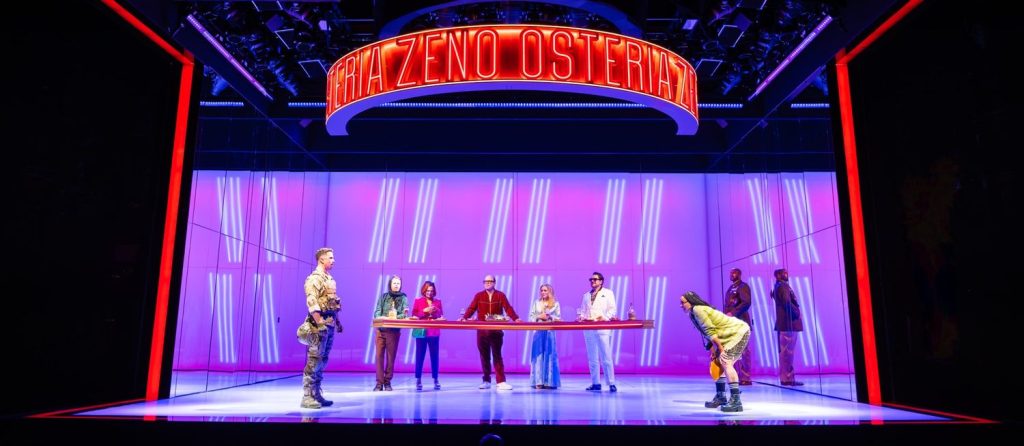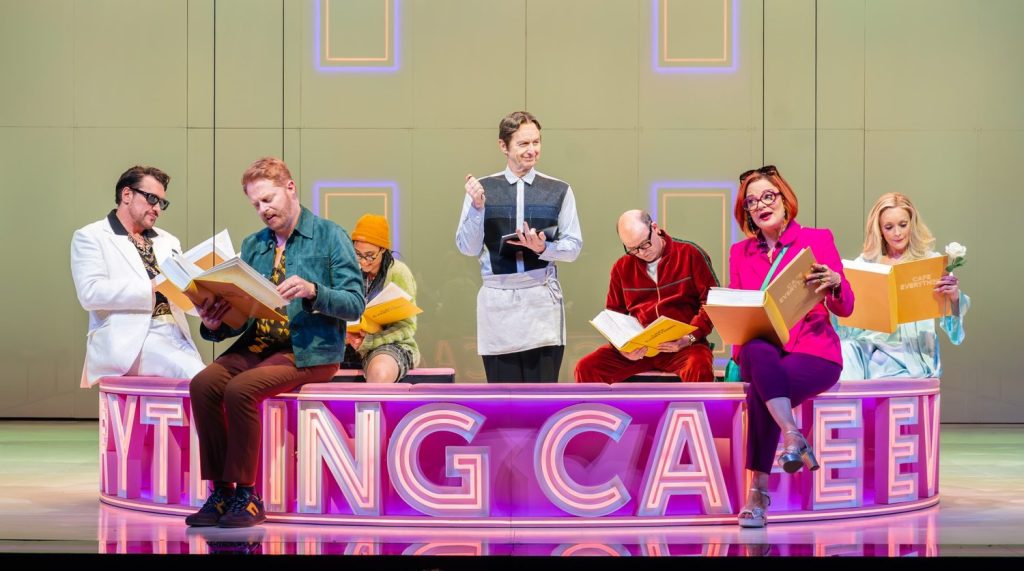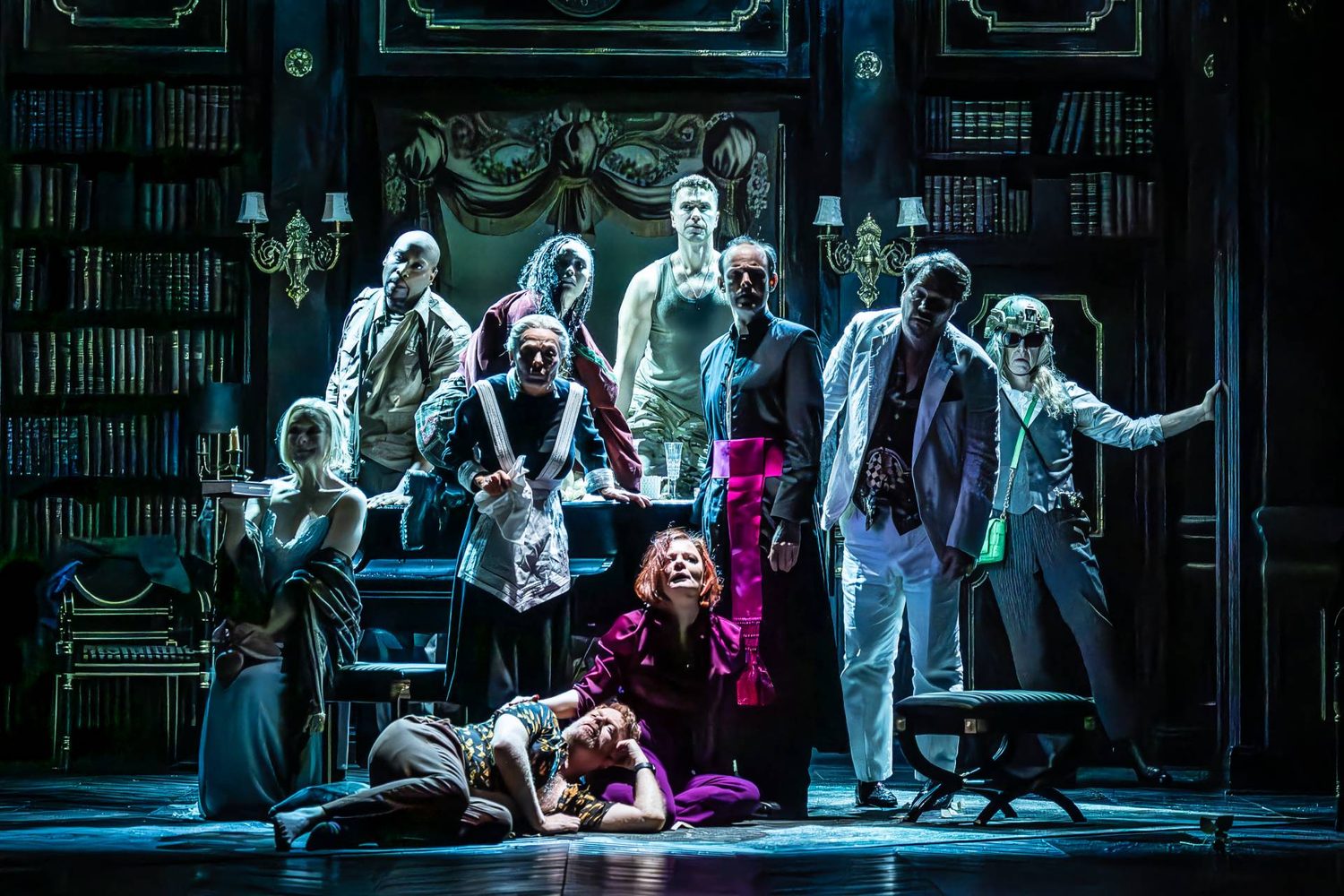Here We Are is the final musical by the late Stephen Sondheim, currently playing at the Lyttelton Theatre. Part musical, part surrealist play, part social farce, it’s the sort of project only Sondheim would attempt, and in many ways, it’s perplexing.
The piece was developed by Sondheim and playwright David Ives, drawing from two Luis Buñuel films: The Discreet Charm of the Bourgeoisie and The Exterminating Angel. Act I loosely follows the former, tracking a group of wealthy friends as they try, again and again, to have brunch, but are thwarted each time by strange disruptions. Act II sees them finally make it to dinner, only to discover they cannot leave the room. There is no physical barrier. They simply can’t cross the threshold. It doesn’t make a huge amount of sense.
From the opening scene, director Joe Mantello’s staging leans into the surreal. The set, designed by David Zinn, is a sterile, mirrored space, slick with privilege and empty of substance, a perfect match for the characters. Rory Kinnear leads the cast as Leo Brink, a hedge fund mogul in a red velour tracksuit who talks about opening a private national park and boasts of his cocaine smuggling days. His wife Marianne, played with breathy charm by Jane Krakowski acting as Jane Kakowski, floats through the show, oblivious and Instagram-happy. Martha Plimpton and Jesse Tyler Ferguson appear as a brittle Hollywood executive and her fretful plastic-surgeon husband. Paulo Szot is a diplomat from a fictional country, full of florid compliments and vague threats. Newcomer Chumisa Dornford-May stands out as Fritz, Marianne’s half-sister, the only one attuned to the rumbling sense that the world is ending.

Act I plays like a brilliant comic sketch or a high-end episode of The White Lotus. At one restaurant, the kitchen has nothing to serve. At another, there’s a funeral in the dining room. At yet another, soldiers are rehearsing a war. Each absurdity is punctuated by dry musical numbers, including a witty patter song by Denis O’Hare’s weary waiter and a torchy lament sung by Tracie Bennett as a failed cabaret singer. Sondheim’s lyrics remain razor sharp, laced with modern references (Teslas, sushi, performance art) all with his usual complex internal rhyme and melodic surprise.
The music in Act I is plentiful and playful. It serves to underscore how trivial these characters’ lives are, how they keep singing about food and shoes while revolution brews outside. Sam Pinkleton’s choreography makes running gags of the constant restarts: the characters repeatedly file into formation to “head off to brunch” as if trapped in an eternal farce. You start to feel uneasy as the absurdity piles up.
That unease boils over in Act II. The characters gather in the ambassador’s home, sit down to dinner, and then simply cannot leave. The tone shifts. There’s barely any music. The party becomes a prison. The show becomes a play. Characters panic, turn on one another, confess secrets, break down. The artificial world of Act I gives way to a cluttered, ornate salon full of creepy details (including, at one point, a bear). It’s here that the seams of the unfinished musical start to show. Sondheim died before completing the second half, and the absence of music feels abrupt. One character even says, “Rest in peace,” as if to mark the score’s end.

Yet the cast keeps the energy afloat. Krakowski finds new depths in Marianne as she shifts from ditzy delight to dazed reflection. Kinnear manages to make Leo both monstrous and oddly sympathetic. Plimpton delivers acidic one-liners with flair, while Ferguson’s physical comedy is a highlight. Dornford-May and Richard Fleeshman (as a tender soldier) share a brief, sweet love song, parodying grand romance while sincerely delivering it. O’Hare and Bennett reappear in various servant roles, stealing scenes with impeccable comic timing.
So what is the show saying? On one level, it’s a brutal satire of privilege, people so consumed with status and comfort that they ignore the rising tide. On another, it’s an existential play about human denial. Faced with mortality, the characters eat, flirt, and argue. It’s ridiculous. The humour is biting, but occasionally tender. Even the most loathsome figures are shown to be, in the end, lost and frightened. There are moments when the absurdity is pushed so far it almost collapses. But Sondheim always had a way of finding the truth in madness, and Ives does a valiant job of sustaining that vision.
Some theatregoers will hate it. And for Sondheim’s last work, that feels appropriate. The master of complexity has left us one final, gloriously unfinished thought. Here it is. Make of it what you will.


